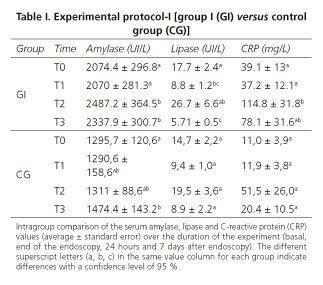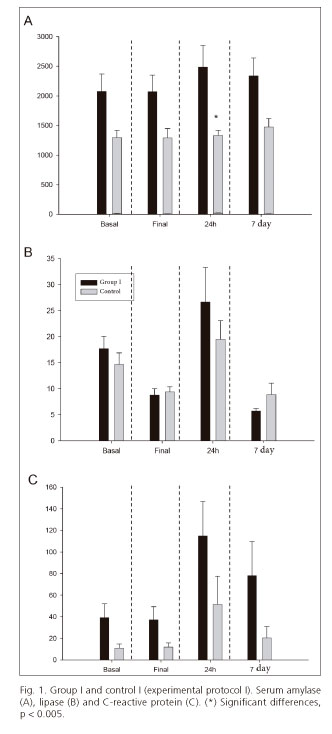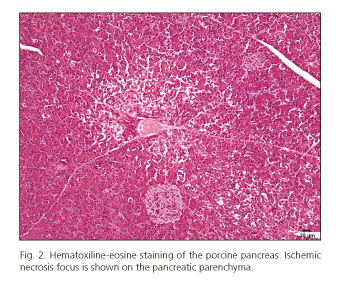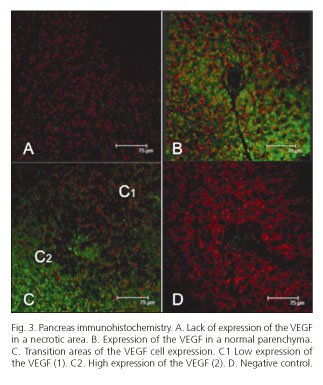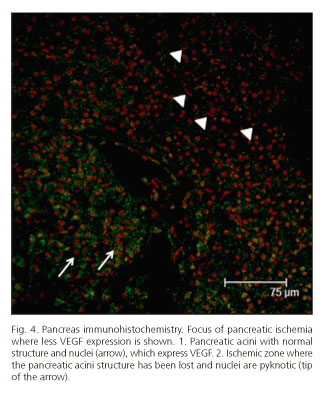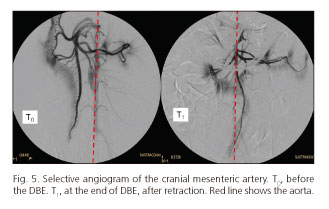Mi SciELO
Servicios Personalizados
Revista
Articulo
Indicadores
-
 Citado por SciELO
Citado por SciELO -
 Accesos
Accesos
Links relacionados
-
 Citado por Google
Citado por Google -
 Similares en
SciELO
Similares en
SciELO -
 Similares en Google
Similares en Google
Compartir
Revista Española de Enfermedades Digestivas
versión impresa ISSN 1130-0108
Rev. esp. enferm. dig. vol.107 no.1 Madrid ene. 2015
Ischemic etiopathogenesis as the possible origin of post-double baloon enteroscopy pancreatitis. A porcine model study
Etiopatogénesis isquémica como posible origen de la pancreatitis secundaria a la enteroscopia de doble balón. Estudio en un modelo porcino
Federico Soria1, Enrique Pérez-Cuadrado2, Octavio López-Albors3, Esther Morcillo1, Ricardo Sarriá3, Eugenia Candanosa3, Pilar Esteban2, Luis Fernando Carballo4, Marc Navarro5, Víctor Nacher5, Francisco Miguel Sánchez1 and Rafael Latorre3
1Endoscopy Unit. Centro de Cirugía de Mínima Invasión Jesús Usón. Cáceres, Spain.
2Department of Digestive Diseases. Hospital Universitario Morales Meseguer. Murcia, Spain.
3Department of Anatomy and Pathology. School of Veterinary. Universidad de Murcia. Murcia, Spain.
4Department of Digestive Diseases. Hospital Universitario Virgen de la Arrixaca de Murcia. Murcia, Spain.
5Centro de Biotecnología Animal y Terapia Génica. Departamento de Sanidad Animal y Anatomía. School of Veterinary. Universitat Autònoma de Barcelona. Barcelona, Spain
ABSTRACT
The aim is to evaluate the pancreatic vascular-ischemic effects related to double balloon enteroscopy in the porcine model as a possible etiopathogenesis of post-enteroscopic pancreatitis. For this reason we carry out two independent experiments in a porcine animal model. In the first arm protocol (group I), 10 animals underwent 90 minutes of oral enteroscopy with 7 days follow-up. The levels of amylase, lipase and C-reactive protein were measured at T0 basal-T1 -90 min, T2-24, T3-7 days. Also we perform upper gastrointestinal endoscopy in a control group. At 7 days, the animals of experimental protocol-I had their pancreases removed for a pathological and immunohistochemical study to evaluate vascular epithelial growth factor (VEGF) expression.
The second experimental protocol in this study aims to evaluate possible changes in vascular topography due to the double balloon enteroscopy (DBE). Group-II (10 animals) underwent oral enteroscopy and selective angiography of the cranial mesenteric artery and celiac trunk. None of the group I or control group animals presented pancreatitis, although the biochemical results for group-I showed increases in the levels of amylase, lipase and C reactive protein at 24 hours. The microscopic study for group-I showed pancreatic necrotic foci and positive VEGF expression, though these changes were not expressed in the control group. These foci were found in 50 % of the group I animals and in relation to the total of the parenchyma were quantified at 6 % of the pancreas. The results for group-II showed that the enteroscopy caused mobilization of the mesenteric vascular axis, with signs of both intestinal and pancreatic hypoperfusion. The conclusions of this study are that, after enteroscopy in the porcine model, pancreatic necrotic foci are produced, in addition to ischemic phenomena causing VEGF expression. This could be related to episodes of visceral hypoperfusion caused by vascular alterations on a topographic level. This can be related to the possible ischemic etiopathogenesis described for post-enteroscopic pancreatitis.
Key words: Pancreatitis. Enteroscopy. Animal model.
Introduction
Double balloon enteroscopy (DBE), first introduced in 2001 by H. Yamamoto, has enabled endoscopic study of a segment of the digestive tract that up until a few years ago was difficult to access completely (1,2). DBE has proved to be a safe technique, with only about 1.2 % percentage of complications. Like any other endoscopic procedure, this technique is associated with certain complications, which have been described in different multi-center studies (3,4). Amongst those complications classified as serious, we can highlight bleeding, associated with therapy, and intestinal perforation which is associated with the treatment of polyps and those patients who had previously undergone abdominal surgery (5). The third important complication after DBE is acute pancreatitis: Nowadays its etiopathogenesis is still under discussion, and the rates of pancreatitis after DBE are 0.2 %-3.2 % (3-11).
At present the most widespread hypothesis is that during the DBE a traumatic injury can be produced, which may or may not be related to an ischemia, which can have a determining effect on the possible apparition of pancreatitis. This potential injury would be caused by the widespread folding of the intestines, which have already been explored, the intraluminal pressure of the overtube and the balloons during retraction, and possibly some kind of torsion of the mesentery (12-14). Another possible etiopathogenesis, which has been described, is the direct injury of the pancreas owing to the compression of the endoscope against the spine (15).
The typical DBE maneuvers with duodeno-jejunal shortening and small intestine displacement could cause traumatic stress, mainly in the body and tail of the pancreas because these portions are less mobile and thus more resistant to deformation, which would affect both the pancreatic parenchyma and its blood supply (9,10,14,16).
Although post-DBE pancreatitis is relatively uncommon, it is the most important complication after oral DBE diagnosis (17). The aim of this experimental study is to evaluate the vascular and ischemic effects related to the pancreas, which occur during a DBE in porcine model as a possible etiopathogenesis of post-DBE pancreatitis.
Material and methods
The experimental protocol was divided into two independent studies. Experimental protocol-I: Study of biochemical and pathological modifications of the DBE and a second experimental protocol: Vascular topographical changes during DBE (experimental protocol-II).
Animals
Twenty-five healthy, large White pigs were used with weights between 45-50 kg. Our institution's Animal Experimentation Ethics Committee approved this experimental activity.
- Experimental protocol-I. Consisting of a group of 10 animals (group I), which were attempt to evaluate pancreatic biochemical and pathological alterations associated with 90 minutes of diagnostic DBE, and control group (CG), consisting of 5 animals, which underwent upper gastrointestinal endoscopy during 30 minutes. This serves as a control group against group I to assess whether the pancreatic pathological and biochemical alterations are representative of the DBE or happen in all upper gastrointestinal endoscopies.
- Experimental protocol-II. A second enteroscopy group consisting in 10 animals where the aim was exclusively to assess whether there were changes in the topography of the cranial mesenteric artery and celiac trunk related to DBE, which could be related to alterations in pancreatic irrigation. No biochemical measurements or pathological studies were taken by the possible interference of the intravenous injection of contrast medium.
DBE (experimental protocol I and II)
The group-I and group-II animals underwent oral DBE, which lasted 90 minutes (Fujinon EN-450T5). The depth reached was evaluated in both groups using the May A (18) technique, which has been recently validated in the porcine model by López Albors et al. (19). The balloons were not insufflated in any of the animals until the biliopancreatic intersection had been passed.
Analytical studies (experimental protocol I)
In the CG and group-I the serum amylase and lipase, as well as the C-reactive protein (CRP) levels were measured at different times: T0-basal, T1-end of the exploration, T2-24 hours, T3-7 days after DBE. It was established that the serum amylase and lipase values needed to be 3 times the basal values, in addition to signs of abdominal pain, in order to indicate acute pancreatitis. Over the 7 days follow-up, the animals treated were evaluated every day to check aspects such as behavioral variations, anorexia, vomiting, diarrhea and pain.
Histological evaluation (experimental protocol I)
The animals in the CG and group-I were sacrificed on the seventh day of the study. During necropsy, macroscopic aspects of the pancreas were evaluated before it was extracted and divided into 1x1x1 cm fragments which were fixed in 4 % paraformaldehyde and embedded in paraffin blocks. In addition to the histopathological study, using hematoxylin/eosin staining, the level of expression of the vascular endothelial growth factor (VEGF) was used as an indicator of the angiogenic processes induced by tissue hypoxia (22). The tissue was incubated overnight at 4 oC with rabbit anti-VEGF primary antibody (SC-507, Santa Cruz Biotechnology Inc.) at a dilution of 1:100. A rabbit biotinylated anti-IgG antibody (Vector Laboratories), at a dilution of 1:100, was used as the secondary antibody. To reveal the marker we used Alexa Fluor® 488 fluorochrome at a dilution of 1:100, conjugated with streptavidin (Molecular Probes), and the nuclear marker TO-PRO®3 iodide (Molecular Probes) at a dilution of 1:100 in PBS.
Selective angiography of the cranial mesenteric artery and celiac trunk (experimental protocol II)
This was only performed in group-II, at T0 and T1. Starting at the femoral artery a hydrophilic guide wire (Radiofocus, Terumo®, 0.035 inch) and a Cobra catheter (Radiofocus Cobra catheter, Terumo®, 5Fr) were inserted until the angiographic catheter reached the cranial mesenteric artery, where the contrast medium was injected to complete the angiogram (Meglumine amidotrizoate and Sodium amidotrizoate; Urografin 76 %, Schering®). The celiac trunk was subsequently catheterized and the process repeated.
Statistical analysis
The values for serum amylase, lipase and CRP were analyzed using the SPSS 19.0 (IBM®) program. Descriptive statistics were obtained and then a variance analysis was performed (repeated measures ANOVA) between the CG and group-I, with the intragroup factor being defined as the time of sampling and (T0, T1, T2, T3), the significance level as 95 %.
Results
Experimental protocol I
Group-I. Depth advanced (353.7 ± 65.9 cm)
- Analytical studies. The results from the biochemical studies for the CG and this group are summarized in table I. No animal in this group presented signs of post-DBE pancreatitis (Fig. 1).
- Histological evaluation. The macroscopic study of the pancreas at the moment of necropsy did not show any effusions, hematomas, hemorrhages or abscesses. When comparing the anatomopathological results of group-I with the CG, there was evidence of disperse areas of ischemic type tissue necrosis with inflamed cell infiltration around the necrotic foci (Fig. 2). These foci were found in 50 % of the animals and in relation to the total of the parenchyma were quantified at 6 % of the pancreas. Of this percentage of the pancreatic parenchyma, 56.2 % of the necrotic foci corresponded to the pancreas tail.
In the immunohistochemical study of the VEGF expression, three important findings should be highlighted. The first is that on the pancreatic parenchyma there were areas where the VEGF was not expressed alongside others where it was highly expressed. The second important point is that there was no VEGF expression in the CG (Fig. 3). Finally, the pancreatic necrosis foci showed lower VEGF expression, as corresponds to areas with non-viable cells (Fig. 4).
Experimental protocol II
Group-II. Depth advanced (311.1 ± 73.2 cm)
The angiography results of the cranial mesenteric artery before and after the DBE, coinciding with the greatest depth reached, showed clear differences. At T0, the cranial mesenteric vascular axis was located mainly to the right, in its usual anatomical position, but it turned completely to the left at T1 (Fig. 5). At T1, which corresponds with the end of the exploration after retraction, a lack of vascular repletion could be seen in the caudal pancreaticoduodenal artery. There was a negative effect on the opacification speed of the branches of the cranial mesenteric artery at T1 with respect to T0. This affected both the vascularization of the pancreas as well as of the small intestine. The perfusion of the straight jejunal arteries decreased due to the reduction of the artery caliber, with a decrease in the network of straight arteries on the mesenteric edge, and a lack of capillary network on the antimesenteric side of the small intestine.
With regards the selective angiography of the celiac trunk, differences could also be seen between T0 and T1. Negative effects were observed at T1 in the perfusion of all the animals in this group for the celiac trunk and the pancreatic blood supply (Fig. 6). None of the animals in this group presented signs of post-DBE pancreatitis.
Discussion
Ten years after the establishment of DBE as the technique of choice for diagnosis and therapy of small intestine, the etiopathogenesis of pancreatitis, one of the most important DBE complications, has yet to be defined. It has been proposed that pancreatitis could be caused by duodenal hyperpressure due to the overtube and by the intestinal shortening produced by the technique itself. Another possible cause may be the obstruction of the pancreatic duct due to direct compression or friction of the papilla by the overtube or the balloons (15,20). Other authors share this opinion, considering that intraluminal duodenal hypertension caused by the DBE balloons may induce duodenal-content reflux in the pancreatic duct, causing enzyme activation and subsequent development of acute pancreatitis (14). However, according to these theories the pancreatic condition should be diffuse and never focused in the body and tail as occurs in the cases of pancreatitis described (6,13,14).
Different studies describe that one maneuver to prevent possible injury in the duodenal papillary region is to avoid insufflating the balloons before reaching the ligament of Treitz (6-8,17), in spite of which hyperamylasemia and pancreatitis symptoms are still detected. Thus, avoiding papilla occlusion or injury caused by the balloon does not seem to be the only solution to post-DBE pancreatitis (21), although it does reduce iatrogenic effects on the pancreas (22).
The possible vascular disorder provoked by the push and pull maneuvers during DBE may be the cause of an increase in the pancreatic enzymes and acute pancreatitis as a consequence of the prolonged compression of the pancreatic blood supply and the traction and compression of the mesentery (15). The results of a study by Zepeda-Gómez et al. on 92 patients associate the vascular theory with direct pancreatic trauma as the main phenomena in the development of post-DBE pancreatitis (8).
In relationship to the above, the proposal of this experimental study was evaluating the vascular effects, which affect the pancreas to corroborate if the vascular etiopathogenic hypothesis is responsible for post-DBE pancreatitis. The different results of the present study enable us to affirm that intestinal and pancreatic perfusion are affected as a result of the DBE.
Firstly, the pathological findings of the pancreatic study show, as do the findings of a previous experimental study in porcine model by Latorre et al. (22), that the DBE provokes pathological alterations related to tissue necrosis principally located on the pancreatic tail. The main finding after the pathological study is the appearance of necrotic foci and the lack of dilation of the pancreatic ducts, as with other authors, do not consider that the hypothesis of the obstruction of the major duodenal papilla or duodenal reflux is solely cause of post-DBE pancreatitis (21). It should be borne in mind that in this experimental study, as is common practice in clinical groups (6-8,21), the balloons were not insufflated in the first duodenal segment, given that this seems to prevent pancreatic iatrogenic yet in spite of this maneuver there were alterations in the serum amylase and lipase, as well as in the CRP at 24 hours or 7 days. A recent clinical study described how post-DBE hyperamylasemia might be associated with an increase in intestinal permeability, caused by damage to the intestinal mucosa due to the friction and pressure of the enteroscope. This fact favors amylase absorption at the intestinal barrier, a circumstance that has been shown by correlating hyperamylasemia with the lactulose/mannitol index, which reflects changes in intestinal permeability (23,24).
The determining factor when considering the ischemic etiopathogenesis as the possible trigger for the pancreatic damage is the results of the immunohistochemical study related to the vascular endothelial growth factor. To date no studies have been published evaluating this hypoxia marker after DBE. VEGF plays an important role in tissue repair, restoring the oxygen supply when blood circulation is insufficient, via capillary neoformation. Amongst other factors, hypoxia has been shown to be the main VEGF transcription inductor (25). On the pancreatic level, VEGF plays an important role in the correct functioning of the pancreas and it has been shown that pancreatic islets respond to the reduction of local oxygen supply with different strategies to increase their oxygenation, including an increase in VEGF expression (26,27).
The VEGF expression in the pancreatic tissue of the group-I animals means we can propose that the torsion or compression of the pancreatic vascularization during DBE provokes a situation of related pancreatic hypoxia and ischemia which, depending on its severity, could trigger pancreatitis symptoms. The pancreatic tail is the portion which reveals most damage as it is the part of the pancreas which has the most limited blood supply, only receiving blood from one branch of the splenic artery, which is the same in both humans and the porcine model used (28).
The angiographic study shows how the topography of the complete mesenteric vascular axis is modified, which is related to the intestinal folding and retraction maneuvers typical of DBE. This modification has effects both on the small intestine and pancreatic blood supply, as can be seen in the caudal pancreaticoduodenal artery. Similar results are obtained in the selective angiography study of the celiac trunk with vascular alterations caused by the DBE. This situation becomes extreme during retraction in the zones of deep insertion. Coinciding with our results, Kita recommends that the enteroscopic overtube should be retracted as gently as possible in order to avoid the traction force having an effect on the pancreas, which would predictably decrease the vascular and traumatic effects on the pancreas (17).
In conclusion, this experimental study shows that oral DBE produces alterations in the celiac trunk and cranial mesenteric artery topography in the porcine model, which could cause episodes of intestinal and pancreatic hypoperfusion as well as necrotic foci from ischemia, which induce an active expression of VEGF in the pancreas. All of this would support the possible ischemic etiopathogenesis described for post-DBE pancreatitis.
References
1. Yamamoto H, Sekine Y, Sato Y, Higashizawa T, Miyata T, Lino S, et al. Total enteroscopy with a nonsurgical steerable double-balloon method. Gastrointest Endosc 2001;53:216-20. [ Links ]
2. Pérez-Cuadrado E, Más P, Hallal H, Shanabo J, Muñoz E, Ortega I, et al. Double-balloon enteroscopy: A descriptive study of 50 explorations. Rev Esp Enferm Dig 2006;98:73-81. [ Links ]
3. Möschler O, May A, Müller MK, Ell C, German DBE Study Group. Complications in and performance of double-balloon enteroscopy (DBE): Results from a large prospective DBE database in Germany. Endoscopy 2011;43:484-9. [ Links ]
4. Mensink PBF, Haringsma J, Kucharzik T, Cellier C, Pérez-Cuadrado E, Mönkmüller, et al. Complications of double balloon enteroscopy: A multicenter survey. Endoscopy 2007;39:613-5. [ Links ]
5. Gerson LB, Tokar J, Chiorean M, Lo S, Decker GA, Cave D, et al. Complications associated with double balloon enteroscopy at nine US centers. Clin Gastroenterol Hepatol 2009;7:1177-82. [ Links ]
6. Jarbandhan SVA, van Weyenberg SJB, van der Veer WM, Heine DG, Mulder CJ, Jacobs MA. Double balloon endoscopy associated pancreatitis: A description of six cases. World J Gastroenterol 2008;14:720-4. [ Links ]
7. Aktas H, Memsink PBF, Haringsma J, Kuipers EJ. Low incidence of hyperamylasemia after proximal double-balloon enteroscopy: has the insertion technique improved? Endoscopy 2009;41:670-3. [ Links ]
8. Zepeda-Gómez S, Barreto-Zuñiga R, Ponce de León S, Meixueiro-Daza A, Herrera-López JA, Camacho J, et al. Risk of hyperamylasemia and acute pancreatitis after double-balloon enteroscopy: A prospective study. Endoscopy 2011;43:766-70. [ Links ]
9. Kopacova M, Rejchrt S, Tachecí I, Bures J. Hyperamylasemia of uncertain significance associated with oral double-balloon enteroscopy. Gastrointest Endosc 2007;66:1133-8. [ Links ]
10. Heine GDN, Hadithi M, Groenen MJ, Kuipers EJ, Jacobs MA, Mulder CJ. Double-balloon enteroscopy: Indications, diagnostic yield, and complications in a series of 275 patients with suspected small-bowel disease. Endoscopy 2006;38:42-8. [ Links ]
11. Sunada K, Yamamoto H. Double-balloon endoscopy: Past, present, and future. J Gastroenterol 2009;44:1-12. [ Links ]
12. Groenen MJ, Moreels TGG, Orlent H, Haringsma J, Kuipers EJ. Acute pancreatitis after double-balloon enteroscopy: An old pathogenetic theory revisited as a result of using a new endoscopic tool. Endoscopy 2006;38:82-5. [ Links ]
13. Kopakova M, Tacheci I, Rejchrt S, Bartova J, Bures J. Double balloon enteroscopy and acute pancreatitis. World J Gastroenterol 2010;16:2331-40. [ Links ]
14. Honda K, Itaba S, Mizutani T, Sumida Y, Kanayama K, Higuchi N, et al. An increase in the serum amylase level in patients after peroral double-balloon enteroscopy: An association with development of pancreatitis. Endoscopy 2006;38:1040-3. [ Links ]
15. Lo SK, Simpson PW. Pancreatitis associated with double-balloon enteroscopy: How common is it? Gastrointest Endosc 2007;66:1139-41. [ Links ]
16. Matsushita M, Shimatani M, Uchida K, Okazaki K. Mechanism of acute pancreatitis after peroral double-balloon enteroscopy. Endoscopy 2007;39:480. [ Links ]
17. Kita H. Pancreatitis, a new complication of double-balloon enteroscopy. Gastroenterol Hepatol 2007;3:923-4. [ Links ]
18. May A, Nachbar L, Ell C. Double balloon enteroscopy (push-and pull enteroscopy) of the small bowel: Feasibility and diagnostic and therapeutic yield in patients with suspected small bowel disease. Gastrointest Endosc 2005;62:62-70. [ Links ]
19. López Albors O, Soria F, Pérez Cuadrado E, Morcillo E, Martín C, Carballo LF, et al. Validity of insertion depth measurement in double-balloon endoscopy. Endoscopy 2012;44:1045-50. [ Links ]
20. Honda K, Mizutani T, Nakamura K, Higuchi N, Kanayama K, Sumida Y, et al. Acute pancreatitis associated with peroral double-balloon enteroscopy: A case report. World J Gastroenterol 2006;21:1802-4. [ Links ]
21. May A, Ell C. Push-and-pull enteroscopy using the double-balloon technique/double-balloon enteroscopy. Dig Liver Dis 2006;38:932-8. [ Links ]
22. Latorre R, Soria F, López-Albors O, Sarriá R, Sánchez-Margallo F, Esteban P, et al. Effect of double-balloon enteroscopy on pancreas: An experimental porcine model. World J Gastroenterol 2012;18:5181-7. [ Links ]
23. Marsilio R, D'Antiga L, Zancan L, Dussini N, Zacchello F. Simultaneous HPLC determination with light-scattering detection of lactulose and mannitol in studies of intestinal permeability in pediatrics. Clin Chem 1998;44:1685-91. [ Links ]
24. Feng N, Dai J, Lu H, Li XB, Gao YJ, Ge ZZ. Hyperamylasemia is associated with increased intestinal permeability in patients undergoing diagnostic oral double-balloon enteroscopy. World J Gastroenterol 2014;14:539-45. [ Links ]
25. Ferrara N. Vascular endothelial growth factor: Basic science and clinical progress. Endocr Rev 2004;25:581-11. [ Links ]
26. Lai Y, Schneider D, Kidszun A, Hauck-Schmalenberger I, Breier G, Brandhorst D, et al. Vascular endotelial growth factor increases functional beta-cell mass by improvement of angiogenesis of isolated human and murine pancreatic islets. Transplantation 2005;79: 1530-6. [ Links ]
27. Lammert E, Cleavert O, Melton D. Induction of pancreatic differentiation by signals from blood vessels. Science 2001;294:564-7. [ Links ]
28. Traverso LW, MacFarlene S. Pancreas autotransplantation-unsuitability of the swine as a model. Transplantation 1987;44:450-1. [ Links ]
![]() Correspondence:
Correspondence:
Federico Soria Gálvez.
Endoscopy Unit.
Centro de Cirugía de Mínima Invasión Jesús Usón.
Cáceres, Spain
e-mail:
fsoria@ccmijesususon.com
Received: 15-04-2014
Accepted: 24-06-2014













